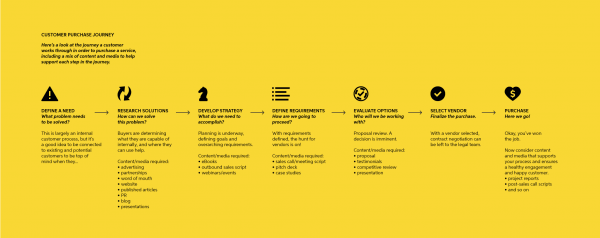Published in How Magazine by Lee Dale, September 18, 2015.
In the digital design world, there’s an essential part of fulfilling the promise of a digital product for a consumer, such as a website that users have to work through. An essential part of the design process for interactive digital media is to map out the user journey and ensure that the design of your product makes the journey as easy to follow and as rewarding as possible.
So what does a user journey look like beyond digital? The user experience journey is the path a user takes when interacting with a brand, whether through a product or service offering. Regardless of the engagement model, the journey begins with a consumer’s first exposure to a brand. This exposure may come in the form or traditional media (print, web, and other advertising media).
In each of these cases, media plays an important role in the customer user experience, and may even lead the customer experience, but it’s just a piece of that experience. And if you’re not considering all of the customer touch points, you may be disconnected from a key piece of the customer journey puzzle, where content, design, and interactions are shaping expectations.
More often than not, this journey doesn’t begin and end with a piece of media. Media, after all, is just one way a customer interacts with a company. Often, customers are interacting in-person, within physical spaces, or with salespeople, all on their own agenda and timeline. (Click image to enlarge.)
It may often seem, when working in isolation on a particular piece of media, that once you complete your work it is a successful project. However, it’s important to recognize that expectations set with other media or customer interactions that may not be reflected in your work can cause friction for customers. This is precisely because the customer views every interaction through the same brand lens, regardless of medium. One company; one set of expectations.
This is why it’s important to frame your work around the customer journey, taking the customer’s lead in coming up with design solutions that tell the same story and set the same expectations across all touchpoints.
Consider these truths:
1. Customer needs transcend departments, as the customer interacts across different digital and physical media or other touchpoints, whether as part of a buying process or for ongoing customer service.
2. When different departments are telling different stories, dealing with issues in different ways, or following different rules, this compounds frustration for customers.
It’s on us as designers to meet the real-world needs of users across all the touchpoints in the business. By mapping out and following these touchpoints, we can begin to see how consumers try to move between them, identify the challenges they face along the way, and find ways to communicate with them to help make that journey more rewarding.
Armed with this knowledge, if you’re working on a print piece or even branching out into digital media, you’ll have the information you need to design the right media. You’ll understand the purpose of that media within the context of where and when a customer is likely to engage in that media. And you’ll be able to create more effective work by understanding how that media leads to and from other channels.
Identifying specific journeys helps to both optimize the media and monitor the consistency and success of the funnel. Of course, there will be many paths, but those most travelled offer the best opportunity to deliver value through optimization. This example focuses on one journey triggered by a call to a potential customer. (Click image to enlarge.)
With that in mind, let’s look at a couple of scenarios where a customer journey moves from digital to physical (or vice versa).
Retail stores: sure there’s a website, but is the design of the in-store experience reflective of the expectations being set online, and vice versa. Does this then hold true for new buyers, for returning customers, for customers who may be looking for help with a return, a gift, or availability of a product. Each of these scenarios is a different journey.
Focusing on returning customers, the media that help bring them back, from marketing storytelling, to promotional media, including email, physical mailers, and POS displays. All of this media has to play its part in the user journey to help ensure that happy returning customer.
Serviced based organization: the primary user journey here is based on the sales cycle; what media does the customer need to see in order to complete a sale. A website may play a key role, but so could a brochure, pitch deck, and other forms of print media. When designing each of these pieces, you have to ensure that a consistent story is being told with clear calls to action to help move the customer through the purchase funnel. depending on where i In other words, where the customer the buying process should greatly influence your design.
In each of these scenarios, you’re responsible for conveying the right detail and information to a customer who expects to move seamlessly between digital and real world channels, if you understand where they are in the journey, then you can integrate the customer’s specific needs into your design.
To help you through the user journey process, ask yourself these questions:
1. Does the media I’m working on serve a customer’s needs based on where they are in their journey?
2. Does the media work within the context of the other media or service the customer’s received along their journey? Does what I’m designing make sense with what the customer just saw or is about to see? With an interaction they’ve had or can expect to have?
3. Now that I have a better understanding of the customer’s needs, can I identify better ways of communicating with the customer through the media I’m responsible for?
4. Does this better way of communicating translate to other channels? And if so, have I shared this information with the other departments responsible so we can collectively improve that customer journey and streamline our communication efforts?
Answer those questions and you’ll be able to not just do better work, but also help out other departments in better understanding and reacting to the customer journey.

About Lee Dale
I help companies bring digital products to market that make a bottom line difference, ensuring that all consumer touchpoints in a product lifecycle meet their promise for the business and its users. Since co-founding Say Yeah, I’ve worked with numerous organizations big and small including Tourism Toronto, Kanetix, Virgin Gaming, and many more. Our work has also helped our clients secure investments and beneficial partnerships with organizations such as Indigo, Microsoft, and Rogers. I have also given talks related to business, technology, and user experience design in Toronto, Montreal, and at SXSW in Austin, Texas.
You can see more articles from Lee on the Digital Insights blog.

